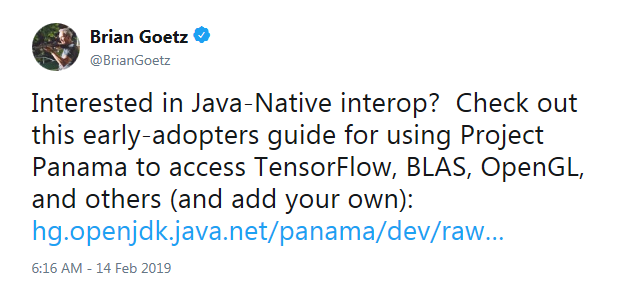We build the Python interpreter into a java application using the Panama project
A couple of days ago I saw Brian Goetz's tweet, but only today my hands reached around to play with examples.
About this and I want to briefly tell.
About the Panama project on Habré already wrote , therefore I will just show couple of simple examples of how it is possible to apply native binder .

First of all, you will need a C compiler. If you are using Linux or MacOS, then you already have it. If Windows, you have to first install Build Tools for Visual Studio 2017 . And, of course, you need OpenJDK with Panama support. You can get it either by assembling the “foreign” branch of the corresponding repository , or by downloading an Early-Access build .
Let's start with a minimal example - a simple function that adds two numbers:
adder.h
adder.c
Example.java
We compile in DLL
We use the utility
And we use the resulting jar file to build and run java code:
While not particularly impressive, but allows you to understand the principle. Now try using python37.dll.
PythonMain.java
We generate interfaces:
Compile and run:
Congratulations, your java-application has just loaded the Python interpreter into itself and executed the script in it!

More examples can be found in the instructions for pioneers .

First of all, you will need a C compiler. If you are using Linux or MacOS, then you already have it. If Windows, you have to first install Build Tools for Visual Studio 2017 . And, of course, you need OpenJDK with Panama support. You can get it either by assembling the “foreign” branch of the corresponding repository , or by downloading an Early-Access build .
Let's start with a minimal example - a simple function that adds two numbers:
adder.h
#ifndef _ADDER_H#define _ADDER_H
__declspec(dllexport) intadd(int, int);
#endifadder.c
#include"adder.h"
__declspec(dllexport)
intadd(int a, int b){
return a + b;
}
Example.java
// импорт jextract'нутых "заголовочных" классовimportstatic com.example.adder_h.*;
publicclassExample{
publicstaticvoidmain(String[] args){
System.out.println(add(3, 5));
}
}
We compile in DLL
cl /LD adder.c
We use the utility
jextractto generate a java interface based on the header file:jextract -L . -l adder -o adder.jar -t "com.example" adder.h
And we use the resulting jar file to build and run java code:
javac -cp adder.jar Example.java
java -cp .;adder.jar Example
While not particularly impressive, but allows you to understand the principle. Now try using python37.dll.
PythonMain.java
import java.foreign.Libraries;
import java.foreign.Scope;
import java.foreign.memory.Pointer;
importstatic org.python.Python_h.*;
importstatic org.python.pylifecycle_h.*;
importstatic org.python.pythonrun_h.*;
publicclassPythonMain{
publicstaticvoidmain(String[] args){
Py_Initialize();
try (Scope s = Scope.newNativeScope()) {
PyRun_SimpleStringFlags(s.allocateCString(
"print(sum([33, 55, 66]))\n"),
Pointer.nullPointer());
}
Py_Finalize();
}
}
We generate interfaces:
jextract -L "C:\Python37" -l python37 -o python.jar -t "org.python" --record-library-path C:\Python37\include\Python.h
Compile and run:
javac -cp python.jar PythonMain.java
java -cp .;python.jar PythonMain
Congratulations, your java-application has just loaded the Python interpreter into itself and executed the script in it!

More examples can be found in the instructions for pioneers .
